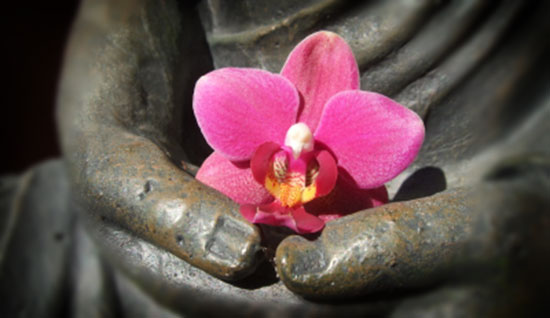In traditional Chinese Zen, the dharma hall had a special status as the place where the Zen master expounded the dharma. It was purposefully separated from the Buddha hall, where statues of the Buddha and other notables provided prominent devotional icons for temple services and visitors. The dharma hall itself, however, was always bare of such figures. Why?
 In the founding legend of Zen, Shakyamuni Buddha holds up a flower and declares, “I possess the treasury of the true dharma eye, the sublime mind of nirvana, whose true sign is signlessness.” The key word here is the last one: according to Zen, the mind of nirvana has no special sign. When Zen masters addressed their monks in the icon-less dharma hall, their stark surroundings represented the significance of signlessness in Zen dharma.
In the founding legend of Zen, Shakyamuni Buddha holds up a flower and declares, “I possess the treasury of the true dharma eye, the sublime mind of nirvana, whose true sign is signlessness.” The key word here is the last one: according to Zen, the mind of nirvana has no special sign. When Zen masters addressed their monks in the icon-less dharma hall, their stark surroundings represented the significance of signlessness in Zen dharma.
If the Zen dharma is signless, why did the Buddha hold up a flower in particular? Must the mind of nirvana be symbolized by a flower alone? Well, no. Zen masters throughout history used a wide range of metaphors to convey signlessness: the moon, a flowing spring, and a mirror were among the most commonly used by the old masters, whose choice of words often echoed the austere beauty of the dharma halls themselves.
One good example of a master’s skilled use of metaphor to convey signlessness was in an ancient dharma hall talk by Fengxue, of the Linji (Rinzai) Zen lineage. Fengxue’s temple was poor, the conditions there cold and harsh. I imagine him speaking in his dharma hall on a frigid night to a few ragged monks under a dim light, a cold wind blowing past the open eaves. In the talk, Fengxue refers to a story where the Buddha is said to have described himself as an archer and craftsman of arrows:
“An ancient said, ‘I have an arrow that I have sharpened for eons. When I shoot, it flies through the ten directions. No one can see where it falls.’ But as for me [Fengxue], I also have an arrow, but it isn’t sharp. When I shoot this arrow, it doesn’t fly through the ten directions. Even so, no one can see it.”
Fengxue probably never imagined that dark night that his dull, signless arrow would fly through the “ten directions” to reach this column today.
—Andy Ferguson
This post is part of author and scholar Andy Ferguson’s new “Consider the Source” series. As an old Chinese saying goes, “When drinking water, consider the source.” In the coming weeks, Ferguson will ask and answer seemingly simple (but in the end, profound) questions about the “source” of East Asian Buddhism, weaving a tale of both spiritual inspiration and political intrigue.
This fall, Tricycle will be traveling to the source itself, China, in a special pilgrimage led by Ferguson and abbot of the Village Zendo Roshi Pat Enkyo O’Hara. Want to come with us? Click here for more information.
Ferguson is the author of Zen’s Chinese Heritage: The Masters and their Teachings, which is used widely by Western Zen teachers, and Tracking Bodhidharma, which offers a wealth of new information about the founder of Chinese Zen Buddhism.
Thank you for subscribing to Tricycle! As a nonprofit, we depend on readers like you to keep Buddhist teachings and practices widely available.